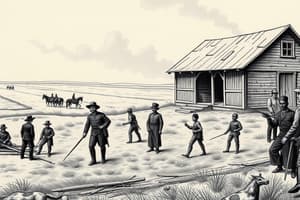Podcast
Questions and Answers
What was Abraham Lincoln's stance on secession during his inaugural address?
What was Abraham Lincoln's stance on secession during his inaugural address?
- He deemed it legally void. (correct)
- He planned to negotiate settlements with the seceded states.
- He encouraged states to secede peacefully.
- He considered it a legitimate political tool.
What event is often considered the official beginning of the American Civil War?
What event is often considered the official beginning of the American Civil War?
- The evacuation of Fort Sumter.
- The surrender of Major Robert Anderson.
- The firing on Fort Sumter. (correct)
- Lincoln's call for volunteers.
Which strategy did the Union adopt to suppress the Confederate rebellion?
Which strategy did the Union adopt to suppress the Confederate rebellion?
- The 'Fortress Strategy'.
- The 'Anaconda Plan'. (correct)
- The 'March to the Sea'.
- The 'Total War' approach.
Who was the commanding officer at Fort Sumter at the time of its surrender?
Who was the commanding officer at Fort Sumter at the time of its surrender?
What was Lincoln's immediate response after the attack on Fort Sumter?
What was Lincoln's immediate response after the attack on Fort Sumter?
What was the primary purpose of the Missouri Compromise of 1820?
What was the primary purpose of the Missouri Compromise of 1820?
How did the Ohio River Valley contribute to the sectional struggle over slavery?
How did the Ohio River Valley contribute to the sectional struggle over slavery?
Which of the following was a result of the Ohio's Black Laws of 1803?
Which of the following was a result of the Ohio's Black Laws of 1803?
What event triggered outrage among Southerners during the debate on Missouri’s statehood?
What event triggered outrage among Southerners during the debate on Missouri’s statehood?
Which geographical line was established as the dividing line for slavery in the Louisiana Purchase lands?
Which geographical line was established as the dividing line for slavery in the Louisiana Purchase lands?
What ideology did the Democratic Party primarily promote during Andrew Jackson's era?
What ideology did the Democratic Party primarily promote during Andrew Jackson's era?
Who were the 'Doughfaces' in the context of Northern Democrats?
Who were the 'Doughfaces' in the context of Northern Democrats?
What phrase was hotly contested during the debates surrounding the Missouri Compromise?
What phrase was hotly contested during the debates surrounding the Missouri Compromise?
Flashcards
Missouri Compromise
Missouri Compromise
An 1820 agreement that admitted Missouri as a slave state and Maine as a free state, creating a temporary balance between slave and free states in the US Senate.
Slavery's Expansion
Slavery's Expansion
The debate about whether slavery should be allowed to spread to new territories acquired by the US, like the Louisiana Purchase.
36°30′ Line
36°30′ Line
The dividing line established by the Missouri Compromise to limit the expansion of slavery above that latitude in future territories acquired in the Louisiana Purchase.
Sectionalism
Sectionalism
Signup and view all the flashcards
Black Laws
Black Laws
Signup and view all the flashcards
Southern Power
Southern Power
Signup and view all the flashcards
Democratic Party
Democratic Party
Signup and view all the flashcards
Doughfaces
Doughfaces
Signup and view all the flashcards
Fort Sumter Attack
Fort Sumter Attack
Signup and view all the flashcards
Lincoln's Response
Lincoln's Response
Signup and view all the flashcards
Anaconda Plan
Anaconda Plan
Signup and view all the flashcards
Lincoln's Secession View
Lincoln's Secession View
Signup and view all the flashcards
Fort Sumter Supplies
Fort Sumter Supplies
Signup and view all the flashcards
Study Notes
Missouri Compromise (1820)
- Marked a critical point in the escalating sectional conflict over slavery.
- Admitted Missouri as a slave state and Maine as a free state.
- Established the 36°30′ line as a dividing line for slavery in the Louisiana Purchase territories.
- Exacerbated the division between slave and free states in the Senate.
- Exposed deep-seated divisions regarding slavery and its expansion.
- Ohio River Valley became a central dividing line.
- Kentucky and Tennessee became slave states.
- Ohio, Indiana (1816), and Illinois (1818) became free states.
- New laws were introduced to limit Black people's access to the West.
- St. Louis, a key Mississippi River trade hub, became increasingly important, tied to powerful enslavers.
Andrew Jackson's Democracy
- Andrew Jackson's presidency saw white men gain land, jobs, and the rights to vote, serve on juries, attend public schools, and serve in armed forces.
- The Democratic Party focused on uniting Americans around white supremacy and expansion.
- The party faced criticism for leaning too heavily on Southern enslavers.
- “Doughfaces” – northern Democrats who favored Southern interests over their own constituencies.
Lincoln's Inaugural Address and Fort Sumter
- Lincoln declared secession "legally void" and intended to use force to maintain federal property in seceded states.
- The attack on Fort Sumter marked the beginning of the American Civil War.
- Union troops in Fort Sumter refused South Carolina's demand to evacuate.
- On April 12, 1861, Confederate forces fired upon Fort Sumter.
- Fort Sumter surrendered on April 13.
- Lincoln called for 75,000 volunteers to suppress the rebellion.
Anaconda Plan
- The Union adopted General Winfield Scott's "Anaconda Plan".
- This strategy aimed to strangle the Confederacy through a naval blockade of coastal ports and inland waterways .
- Ground troops were to advance into the interior.
Studying That Suits You
Use AI to generate personalized quizzes and flashcards to suit your learning preferences.




